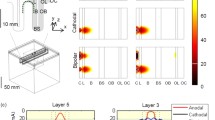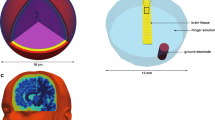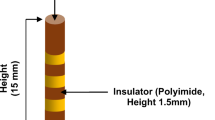Abstract
Purpose
Subdural cortical stimulation is known to be useful in treating brain disorders by injection of electrical current through electrodes beneath the dura matter. However, due to huge experimental cost, it has been rarely investigated precisely how subdural cortical stimulation has to be applied to yield the most effective results. As an alternative, the computational study for subdural cortical stimulation is greatly beneficial for this purpose and it is necessary to develop well-established simulation environment for computational cortical stimulation study.
Methods
We developed a modeling procedure for subdural cortical stimulation, and its simulation environment, called E-CoCS (Environment of Computational Simulator for Cortical Stimulation). Based on our brain modeling method, which specializes in subdural cortical stimulation, the user can predict electric potential, electric field, and current density induced in subdural cortical stimulation depending on electrode type, position, and stimulation amplitude without any coding or scripting.
Results
E-CoCS includes an anatomically realistic human brain model using a pre-meshed surface and provides 2 types of electric property for white matter (isotropic or anisotropic electric conductivity). In post-processing, E-CoCS offers 3 kinds of modality (electric potential, electric field, current density distribution) in a surface or slice view.
Conclusions
E-CoCS can be an excellent tool in investigating the effects or mechanisms of subdural cortical stimulation under the various conditions. It provides user-friendly GUI, computing and visualization environment under the realistic brain model. Since E-CoCS is freely distributed and easily accessible to any investigators, it would be helpful in stimulating this field in the near future.
Similar content being viewed by others
Refrerences
Saitoh Y, Kato A, Ninomiya H, Baba T, Shibata M, Mashimo T, Yoshimine T. Primary motor cortex stimulation within the central sulcus for treating deafferentation pain. Acta Neurochir Suppl. 2003; 87:149–52.
Hosomi K, Saitoh Y, Kishima H, Oshino S, Hirata M, Tani N, Shimokawa T, Yoshimine T. Electrical stimulation of primary motor cortex within the central sulcus for intractable neuropathic pain. Clin Neurophysiol. 2008; 119(5):993–1001.
Strafella AP, Lozano AM, Lang AE, Ko JH, Poon Y-Y, Moro E. Subdural motor cortex stimulation in Parkinson’s disease does not modify movement-related rCBF pattern. Mov Disord. 2007; 22(14):2113–6.
Moro E, Schwalb JM, Piboolnurak P, Poon YY, Hamani C, Hung SW, Arenovich T, Lang AE, Chen R, Lozano AM. Unilateral subdural motor cortex stimulation improves essential tremor but not Parkinson’s disease. Brain. 2011; 134(Pt 7):2096–105.
Kim D, Jun SC, Kim H. Computational study of subdural and epidural cortical stimulation of the motor cortex. Conf Proc IEEE Eng Med Biol Soc. 2011; 7226–9.
Seo H, Kim D, Jun S. A comparative study of the 3D precentral gyrus model for unipolar and bipolar current stimulations. Conf Proc IEEE Eng Med Biol Soc. 2012; 1892–5.
Kim D, Seo H, Kim H, Jun SC. The computational study of subdural cortical stimulation: a quantitative analysis of voltage and current stimulation. Conf Proc IEEE Eng Med Biol Soc. 2012; 867–70.
Seo H, Kim D, Jun SC. Comparison of neuronal excitation between extruded slab partial head model and full head model in subdural cortical stimulation. Conf Proc IEEE Eng Med Biol Soc. 2013; 241–4.
Güllmar D, Haueisen J, Reichenbach JR. Influence of anisotropic electrical conductivity in white matter tissue on the EEG/MEG forward and inverse solution. A high-resolution whole head simulation study. Neuroimage. 2010; 51(1):145–63.
Fang Q, Boas DA. Tetrahedral mesh generation from volumetric binary and grayscale images. Conf Proc IEEE Int Symp Biomed Imaging. 2009; 1:1142–5.
Han X, Fischl B. Atlas renormalization for improved brain MR image segmentation across scanner platforms. IEEE T Med Imaging 2007; 26(4):479–86.
Si H. On refinement of constrained Delaunay tetrahedralizations. Proc Int Meshing Roundtable. 2006; 1:509–28.
Smith SM. Fast robust automated brain extraction. Hum Brain Mapp. 2002; 17(3):143–55.
Kim D, Jun SC. 3-Dimensional mesh generation method for simulating implantable medical devices. Conf Proc Korean Soc Med Biol Eng. 2012; 262–3.
Grandori F, Ravazzani P. Magnetic stimulation of the motor cortex-theoretical considerations. IEEE T Biomed Eng. 1991; 38(2):180–91.
Windhoff M, Opitz A, Thielscher A. Electric field calculations in brain stimulation based on finite elements: an optimized processing pipeline for the generation and usage of accurate individual head models. Hum Brain Mapp. 2013; 34(4):923–35.
Jung Y, Kim J, Im C-H. COMETS: A MATLAB toolbox for simulating local electric fields generated by transcranial direct current stimulation (tDCS). Biomed Eng Lett. 2013; 3(1):39–46.
Author information
Authors and Affiliations
Corresponding author
Rights and permissions
About this article
Cite this article
Kim, D., Seo, H., Lee, Mj. et al. E-CoCS: Environment of computational simulator for cortical stimulation. Biomed. Eng. Lett. 4, 186–192 (2014). https://doi.org/10.1007/s13534-014-0138-y
Received:
Revised:
Accepted:
Published:
Issue Date:
DOI: https://doi.org/10.1007/s13534-014-0138-y




